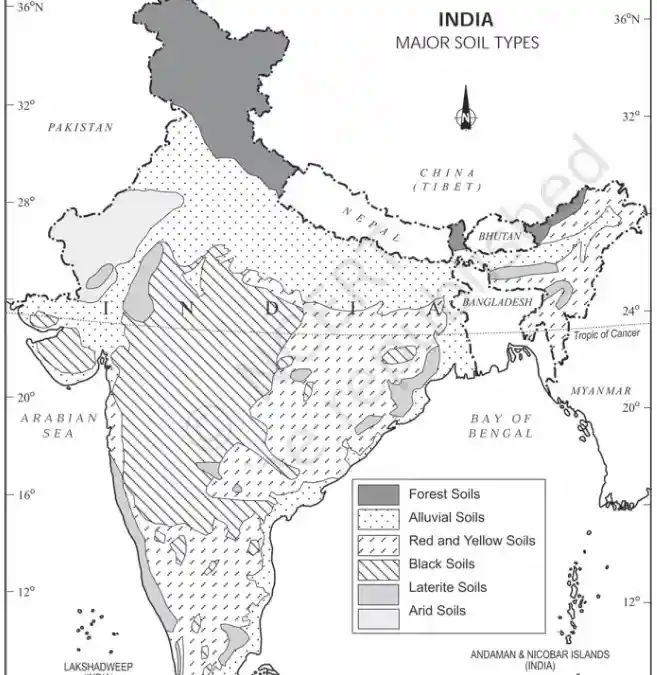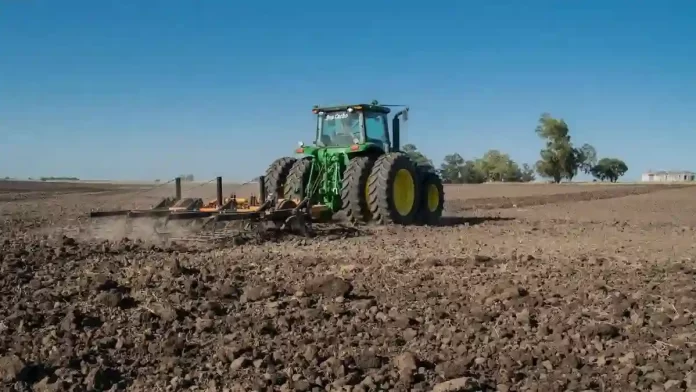Introduction
Soil is a mixture of minute rock particles and organic materials formed gradually on the earth’s surface and supports the growth of plants and vegetation.
Indian landmass is blessed with so many types of soil with varying degrees of fertility and utilities.
Some of the major types of soil found in India include alluvial soil, black soil, red and yellow soil, laterite soil, arid or desert soil, saline soil, peaty soil, forest soil, etc.
Major Types of Soil Found in India
On the basis of their specific color, composition, and location, the Indian Council of Agricultural Research (ICAR) has classified the soils found in India into the following 8 categories.

Alluvial Soils
Alluvial soils are the most fertile of all soils found in India. They cover almost 40 percent of the total landmass of India and thus making it the most widespread soil in India. Large parts of the Indo-Gangetic plains and river valleys are covered with Alluvial soil.
Formation
Alluvial soils are formed by the gradual deposition of silts by rivers and streams. And hence, they are also known as depositional soils.
Khadar and Bangar
Khadar is the old Alluvial while Bangar is the new Alluvial formed recently by the flooding actins of rivers.
Texture and Characteristics
Alluvial Soil is clayey and loamy in texture. In the foothills of the Himalayas, it also contains calcareous contents called “Kankars”. In terms of color, this soil is greyish with differing variations.
Crops
As the alluvial soil is rich in humus content due to silt deposits, it supports a wide variety of crops. Crops like wheat, rice, maize, sugarcane, pulses, oilseed, etc are cultivated extensively in northern areas of India rich in alluvial soil.
Fertility and Mineral Content
Alluvial soils are sufficiently rich in humus, potash, and organic matters. But they are poor in phosphorous.
Red and Yellow Soils
Red and Yellow soils are the second-most widespread soil in India after the Alluvial soils. They cover over 18 percent of the total landmass of India. They are mainly found on western ghats and some parts of Odisha and Chhattisgarh.
Formation
Crystalline igneous and metamorphic rocks in rain deficient areas of the eastern and southern part of the Deccan Plateau play a major role in the formation of red and yellow soils.
Texture and Characteristics
As red and yellow soils are found in the iron belt of India, they develop a reddish hue due to a wide diffusion of iron in crystalline and metamorphic rocks. In hydrated form, the red soil acquires a yellowish tint.
Fertility and Mineral Content
Whereas the fine-grained red soil is fertile, the coarse-grained one is less fertile. It is poor in nitrogen, phosphorous, and humus.
Crops
In areas rich in fine-grained red soils, Farmers grow cotton, wheat, pulses, oilseeds, potato, and tobacco, etc.
Black Soils
Black soil is also known as “Regur” and they cover most of the south-eastern regions of the Deccan plateau of India.
Formation
Black soils are the result of volcanic activities in the Deccan plateau in ancient times.
Texture and Characteristics
The black soils are soft, clayey, and impermeable i.e they don’t allow the water to pass through them easily.
When wet, they are soft and sticky but when dried, they shrink and become hard like rocks. In dry seasons, they develop wide cracks as can be found in dry beds of ponds and lakes in northern India. This action is also known as “self-ploughing”.
Further, as the rate of absorption and loss of moisture is slow, they tend to retain moisture for a long time.
Fertility and Mineral Content
Black soils are fertile enough to support a wide range of crops like cotton, groundnuts, oilseeds, and sugarcane. In terms of mineral contents, they are rich in lime, potash, iron, magnesia, and alumina. They are poor in phosphorous, nitrogen, and organic contents
Crops
Black soils are suitable for crops like cotton which are extensively grown especially in south-eastern Gujarat, south-western Madhya Pradesh, and the north-western regions of Maharashtra.
In addition, crops like sugarcane, potato, oilseeds, groundnuts, pulses, soybean, etc are also grown in some regions of Madhya Pradesh and Maharashtra.
Laterite Soils
Laterite in the Latin language means brick. Laterite is rock-type soil found mainly in northeastern parts of the Deccan plateau, and some parts of Andhra Pradesh, Karnataka, Tamil Nadu, and Kerala in southern India.
Formation
Laterite soils are formed in areas having high rainfall and high temperature. Due to intense leaching, lime and silica contents are gradually washed away while the iron oxide and aluminum compounds are left behind.
Texture and Characteristics
Laterite soils have a soft and yellowish texture. Like Black soils, they become hard on drying and hence widely used in making bricks.
Fertility and Mineral Content
These soils are not suitable for growing crops as they are infertile. Laterite soils are poor in humus, organic matters, nitrogen, phosphate, phosphorous, potassium, lime, magnesia, and calcium. But they contain an excessive amount of iron-oxide and potash contents.
Crops
As discussed earlier, laterite soils are not suitable for growing crops. After proper application of manure and fertilizers, tree crops like cashew nuts are grown in some regions of Andhra Pradesh, Tamil Nadu, and Kerala.
Arid Soils
Arid or desert soils are widespread in the desert and arid regions of the nation. It is the least fertile of all soils found in India. Ancient Indians classified it as “usara” or infertile.
Formation
Arid soils are found in desert areas of Rajasthan and Gujarat. Their formation and characteristics are affected by low precipitation, high temperature, and high rate of evaporation.
Texture and Characteristics
Arid soils are sandy and grainy in nature. They are also saline due to high evaporation and low rainfall in desert areas. In terms of color, they look red and light brown.
Fertility and Mineral Content
Arid soil is not very fertile. As they are found in desert areas with high temperatures and low rainfall, they lack moisture and decaying matters like humus.
Further, it is deficient in nitrogen but contains phosphate in varying degrees. The calcium content increases with depth.
Crops
They don’t support a wide variety of crops. They mostly remain barren throughout the year. In some areas, however, Bajra and Millets, etc are cultivated that require less water.
Saline Soils
Saline soils are mostly found in arid and semi-arid regions of the country. And as the name suggests, these saline areas are mostly near the coasts.
They are widespread in the Rann of Kutch region of western Gujarat and deltas of the eastern coast.
Formation
The soils in the arid and semi-arid regions become saline due to dry climate, high rate of evaporation, and poor drainage.
As they are near coastal areas, their formation and salinity are also affected by the oceanic phenomena and intrusion of tidal currents.
In a worrying trend, fertile alluvial soil in dry regions of Punjab and Haryana is also turning saline due to excessive irrigation and exploitation.
Texture and Characteristics
The texture of saline soils varies from loamy to sandy. Those near the oceans are comparatively more sandy.
Fertility and Mineral Content
Saline soils are infertile for vegetative growth. As the name suggests, Saline soils are rich in salt and sodium contents. This is due to poor drainage and a dry climate.
They also contain a large proportion of magnesium and potassium and lack nitrogen and calcium. All this renders them infertile for crop cultivation.
Crops
As saline soils are mostly infertile, they are not fit for the cultivation of a wide variety of crops. Only plants and crops like date palms, barley, sugarbeet, cotton, spinach, asparagus, etc that are tolerant to high salt content can survive here.
Peaty Soils
Peaty soils are found in wet areas with abundant rainfall. These areas include southern Uttarakhand, northern Bihar, and coastal areas of Bengal, Orissa, and Tamil Nadu.
Greater water accumulation in these areas results in a high rate of decomposition of organic contents which increases the humus content of peaty soils.
Formation
Peaty soils are formed by the decomposition of organic materials and plants over a period of time.
A wet climate, excessive rainfall, and water accumulation aids in the formation of peaty soil.
Texture and Characteristics
Due to the high amount of humus and organic contents, peaty soils are generally dark, heavy, and alkaline.
Fertility and Mineral Content
Peaty soils are extremely fertile for crop cultivation due to the high amount of decomposed organic materials and humus found in them.
Crops
As Peaty soils are extremely fertile and rich in humus content, they support a wide range of crops including wheat, rice, pulses, etc.
Forest Soils
Forests and Mountain soils are found in forested and mountainous regions of the country with sufficient rainfall. These include the lower and middle Himalayas and eastern India.
Formation
Forest soils are formed in forested areas with sufficient rainfall. Silting actions of rivers also affect their fertility and consistency.
Texture and Characteristics
In the hilly and mountainous regions, forest soils are coarse-grained with lots of “Kankars”. But in the lower valleys and plain areas, they are fine-grained, loamy, and silty.
Fertility and Mineral Content
Forests soils in the plain and valley regions are generally fertile and support a wide variety of crops and vegetation. However, in the upper Himalayas where they experience denudation due to heavy snowfall, they are acidic and infertile.
Further, they are rich in humus and organic matters but poor in lime, potash, and phosphorous.
Crops
In areas having fertile forest soils, people grow crops like wheat, tea, coffee, barley, maize, etc. They are also good for cultivating tropical and temperate fruits.
Conclusion
In conclusion, all major types of soils are found abundantly in India. Some like alluvial and peaty soils are extremely fertile while others like arid and saline soils are infertile for good vegetative growth.
Soils are generally fertile if they contain a good amount of humus, organic matter, nitrogen, potash, calcium, etc. They are infertile if there is a high amount of salt, sodium, potassium, magnesium, etc.
Soils are a valuable resource for humankind as it supports vegetative growth, crop cultivation, and biodiversity.
To prevent their degradation, there is a need for their conservation and judicious and sustainable use.
Also Read| Environment Impact Assessment in India
